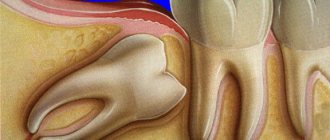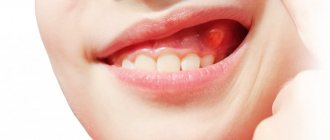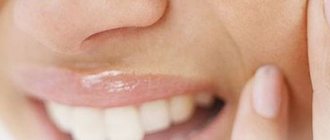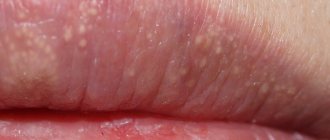My cheek is swollen after dental treatment - what to do?
- Dentistry Kyiv | Dental clinic in Kyiv. Solomenka.
- >
- Articles
- >
- My cheek is swollen after dental treatment - what to do?
Sometimes after tooth treatment (especially after removal and root canal treatment), an alarming picture is observed - a swollen cheek. Moreover, such a picture can be observed even after visiting a highly qualified specialist who did not make a single mistake during the therapeutic procedures. What causes this complication, and how to act when it occurs?
What are the main causes of swelling with pain?
The main cause is inflammatory processes of periodontal tissues, which are caused by a number of pathological conditions.
- Advanced caries, bad habits, ignoring hygiene rules or poor-quality root canal filling. In most cases, swelling of the cheek is preceded by pain localized on the side of the affected tooth. The source of inflammation is located in the root area and after a few days a flux can form, which without treatment transforms into an abscess.
- Very often, swelling of the cheek occurs due to disruption of the eruption of wisdom teeth. In this case, purulent inflammation is caused by the formation of a pocket (hood) between the gum and the dental unit itself. In addition, due to lack of space in the jaw arch, molars can occupy an unphysiological position and injure the buccal mucosa.
- Inflammation caused by infection of the socket after the removal of a molar very often leads not only to swelling of the cheek, but also to more serious consequences.
- A dental cyst is characterized by asymptomatic formation over a long period of time; when it increases to 5-7 mm, the neoplasm presses on the bone. The pathology is characterized by acute throbbing pain, accompanied by swelling and redness of the gums, as well as deterioration of the general condition.
The danger of inflammatory processes in the oral cavity lies in the close proximity of pathogenic swelling to the tissues of the face and brain. If left untreated, there is a high risk of phlegmon and abscess formation, which in extreme situations can lead to death.
When should you make an appointment with a doctor?
Swelling of the cheek is a symptom of an acute inflammatory process, in which you need to urgently seek medical help. Other reasons to visit a dental clinic are:
- redness and looseness of the gum tissue,
- bleeding when brushing teeth,
- constant metallic taste in the mouth,
- discomfort and pain,
- uneven height of the gingival margin,
- exposure of the necks of the teeth,
- discharge of pus from under the gums.
The temperature often rises, appetite disappears, and weakness occurs. These are symptoms of intoxication of the body.
The tooth does not hurt, but the cheek is swollen - the causes of the pathological condition
Very often, swelling is a consequence of an allergy to materials used for filling, prosthetics and treatment of dental units. In addition, the clinical situation may be associated with the body's reaction to food, pollen, dust or pet hair. In this case, the swelling does not have a clear localization and can spread to the area of the nose, lips and eyes. .
It should be understood that after the removal of a tooth, nerve or dissection of the gum, swelling and pain are considered normal and can persist for a week after the intervention. You should also exclude respiratory and viral pathologies accompanied by enlarged submandibular lymph nodes (mumps, pharyngitis), high body temperature, and chills.
Another reason is bruises and injuries to the face; in addition, the cheek may swell due to neurological disorders, for example, inflammation of the nerve. The problem is indicated by pain in the throat and parotid region, hearing impairment, facial expressions and diction.
The appointment includes consultation and drawing up a treatment plan with cost determination
sign up for a free consultation
Not ready for an in-person consultation with a doctor? Ask your question by phone
The mechanism of swelling due to bruise
To effectively remove swelling on the face from a blow, first of all, you should understand how the process of its formation itself takes place. Thus, from sharp compression of tissues at the site of impact or sharp pressure, the integrity of tissues and small blood vessels is damaged. At the same time, the skin is stronger, it is usually intact, but under it, fragile vessels burst from compression, and fluid is released from the tissues.
These two factors provoke the appearance of swelling. In this case, at first the swelling is soft and in many cases quickly increases in size, and then after 8–10 hours a hematoma begins to appear. The blood under the skin hardens, the skin first turns purple, gradually turning into dark blue and then purple.
If the blow was strong, the swelling will not go away for several days. And the purple spot will increase in size for about three days and only then will begin to lose its color and go away.
What to do if swelling appears?
The appearance of swelling is an alarming signal and requires immediate action. They can significantly reduce the risk of large swelling and bruising.
So, all activities can be divided into several stages:
- urgent and immediate assistance immediately after the impact;
- consultation with a doctor is required if nausea, dizziness, or redness of the eye occur;
- treatment of edema and hematoma.
Urgent care for swelling from a bruise
It is very important to apply cold to the impact site immediately after the incident. Usually everyone advises to apply ice, but it is important to do this as quickly as possible, so it is not necessary to look for ice. You can use any cold object that is close, for example, a metal spoon. And then look for a more permanent source of cold.
The cold will stimulate the constriction of the blood vessels, which will stop the bleeding and stabilize the situation. The less blood there is under the skin, the less swelling there will be, and in the future, a hematoma (bruise).
Be sure to keep it cold for at least 1 hour. A short time will not allow the burst vessels to thrombose, and the blood will flow further, which will cause an increase in swelling and hematoma.
What are the main treatments for cheek swelling?
The ATLANTIS DENTAL medical center has created ideal conditions for the diagnosis and treatment of dental diseases of any complexity. If you find that your cheek is swollen, you should urgently visit a doctor. Experienced therapists and surgeons will quickly and painlessly eliminate the problem, which will avoid unwanted complications.
- During the consultation, the doctor collects anamnesis, performs a dental examination, and prescribes diagnostic measures (x-rays, CT scans, blood tests, etc.).
- If necessary, the patient is referred for consultation to specialized specialists: neurologist, otolaryngologist, endocrinologist, etc.
- Based on the results of the examination, a treatment regimen is determined.
- When cystic neoplasms, pulpitis and inflammation of the periosteum are detected, surgical intervention is necessary.
- It may also be necessary to remove the tooth or refill the canals.
Good results are shown by treatment with antibacterial drugs, rinsing the mouth with antiseptics and applying dental gels to the affected areas.
The mechanism of formation of swelling and bumps during a bruise
Immediately after the injury, the swelling is soft. It is growing quickly. After a few hours, the blood clots and a hematoma appears. Solidified blood is dark red at first, turning blue, then purple.
Hemorrhage has several mechanisms of spread. A cavity forms in the interstitial space, which fills with blood, or injured tissues become saturated with blood without forming a cavity. Swelling on the face is more pronounced than on other parts of the body. This is due to many capillaries and fat cells.
How to relieve the condition at home?
To alleviate the condition before visiting a doctor, you can relieve pain and reduce swelling of the cheek with home remedies.
- A pronounced anti-inflammatory effect is exerted by rinsing infusions made from oak bark or calendula, chamomile, and sage inflorescences. To prepare the solution, two tablespoons of raw material are steamed with boiling water and infused for 15-30 minutes, after which rinsing is carried out three to four times a day.
- The soda-salt solution effectively relieves pain, reduces swelling and has a pronounced antiseptic effect. To do this, the components in the amount of 15 g (1 tsp) are stirred in a glass of warm water and used for their intended purpose.
- Dental ointments and gels, which are applied by application to the affected area 2-3 times a day, have proven themselves well.
- Pharmacy antiseptics are always effective, regardless of the causes of swelling of the cheek and gum tissue. Among the most popular: Chlorhexidine, Miramistin, Furacilin, hydrogen peroxide.
If your health worsens and you suspect an allergy, you need to take antihistamines, such as: Tavegil, Zodak, Suprastin, Kestin, etc. To relieve pain, take analgesics or NSAIDs - non-steroidal anti-inflammatory drugs.
Important! In case of severe swelling of the cheek, “tugging” pain, high body temperature and respiratory dysfunction, urgent hospitalization is necessary. Symptoms may indicate anaphylactic shock or sepsis.
Inspection after first aid
After applying cold, the condition of the victim should be assessed. How big is the swelling? It's just a swelling or a big lump. What color is she: pale? Immediately flushed? Or is there a noticeable bruise? Where exactly did the swelling form: eye, cheek, lip, soft tissue? It is important to clarify whether there is dizziness or nausea. All types of swelling on the face after a blow can be divided into the following categories:
Soft tissue swelling
There may be swelling or bumps (on the forehead, cheeks, cheekbones), but their color will be pale or slightly pink. It's important to keep the cold as long as possible, but you shouldn't let your face get cold.
This swelling can be removed using ointments or folk remedies. As a rule, applying cold for a long enough time will effectively help relieve swelling and bumps. You need to hold it until the swelling goes away, this significantly reduces the possibility of a subcutaneous hematoma.
Swelling of the lip(s)
The lips are supplied with a large number of blood vessels, which makes the swelling very noticeable. In addition, delicate skin is more susceptible to tears than on the cheeks. Therefore, along with swelling, small wounds oozing blood often appear on the lips. To quickly remove puffiness, you need to follow these steps.
- Apply cold to the area of swelling.
- Treat the wound with an antiseptic. If the lip is too cut and the bleeding does not stop, a stitch may need to be placed.
- In any case, lubricate the swelling with a gentle ointment, but so that the medicine does not get into the open wound.
- Treat the wound until it dries. And apply medicine to relieve swelling.
Bruised eye
Swelling will occur around the eye, and this can happen even when the blow falls on the bridge of the nose or cheekbone. There are a large number of blood vessels around the eyes, and there is practically no adipose tissue. The likelihood of swelling and hematoma occurring here is very high.
In this case, it is important to immediately pay attention to whether redness has appeared in the eye. With this alarming symptom, two things should be done:
- Apply cold to the bruised eye.
- Contact an ophthalmologist immediately.
These actions must also be done when double vision, dizziness or nausea appear in the eyes.
In all other cases, swelling under the eye can be removed in the same way as in other places on the face. You just need to remember that the skin around the eyes is very delicate; applying the ointment should be alternated with fatty creams.
Medications to relieve swelling from the face after a stroke
The resulting swelling should be shown to a traumatologist so as not to miss serious complications.
Reason to see a doctor:
Extensive area of edema;
The impact damaged the eye;
Combination of injury with fever, dizziness, headache, unusual sensations;
Swelling persists for 3-5 days.
If there are no serious symptoms, you can try to remove the swelling from the face after the blow yourself. For this purpose medications are used:
Ointments with Arnica, Comfrey, Larkspur;
A proven remedy for eliminating swelling is Badyaga, the skeleton of a freshwater sponge crushed into fine powder. When using all medications, you should take into account contraindications for use and carefully follow the instructions. With proper use of these gels and ointments, you can reduce the duration of swelling by several days.
Consequences of a jaw bruise
Negative consequences of a jaw strike:
- tooth damage;
- inflammation of bone tissue;
- limitation of joint mobility;
- traumatic brain injury, concussion;
- deformation of the nose, which causes breathing problems, development of chronic sinusitis, rhinitis;
- inflammation of the hematoma;
- cyst formation.
A severe blow can cause asphyxia, shock, scarring, even disability if the eye or optic nerve is affected. Pain and hematoma can hide damage to the facial skeleton, especially during the formation of the periosteum.
No one is immune from such a nuisance - you may not be a professional participant in “fights without rules” and get hit in the face after a fall, as a result of unsuccessful braking and many other reasons. If you take care in a timely manner about how to remove swelling from the face after an impact, you can significantly reduce the consequences of the injury.
What to do immediately after being hit in the face?
The reason for the appearance of a tumor on the face after an impact is a violation of the integrity of the subcutaneous capillaries and tissues. The skin itself may remain undamaged, but blood and lymph from damaged vessels accumulate under the epidermis layer. In order to stop or minimize this process in time, you need to urgently apply cold to the site of the impact. Ideally, this is ice from the freezer, wrapped in a plastic bag and a linen napkin.
If there is no ice, apply the following to cool the impact site:
A napkin soaked in cold water, green tea (such a compress needs to be refreshed more often);
Copper or any other coin.
All these measures are applicable if the integrity of the epidermis is not compromised and there is no risk of wound infection. Applying cold is advisable in the first 15-20 minutes after injury; after a quarter of an hour, it will no longer be possible to prevent subcutaneous hemorrhage.











